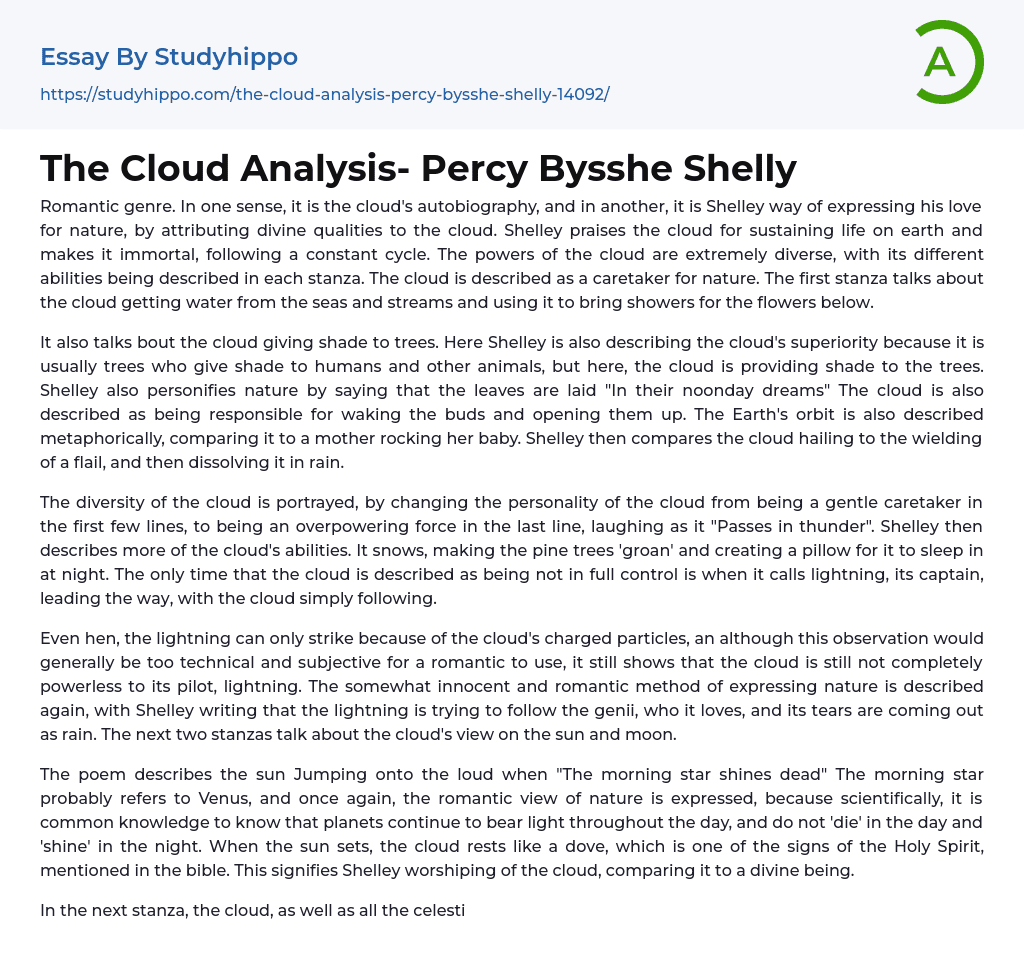The Romantic genre is characterized by Shelley's way of expressing his love for nature through attributing divine qualities to the cloud, which serves as an autobiography of the cloud. Shelley admires how the cloud sustains life on earth and portrays it as immortal, following a continuous cycle. Each stanza describes the various abilities of the cloud, which acts as a caretaker for nature. In the first stanza, the cloud obtains water from the seas and streams, using it to provide showers for the flowers below.
This passage discusses the cloud's ability to provide shade to trees, which is unusual because it is typically trees that provide shade to humans and other animals. Shelley personifies nature by suggesting that the leaves are laid "In their noonday dreams." Additionally, the cloud is credited with waking the
...buds and causing them to open. The Earth's orbit is metaphorically likened to a mother rocking her baby. Moreover, the cloud's hail is compared to the swinging of a flail before dissolving into rain.
The cloud's diversity is depicted in various ways. Initially, it is depicted as a gentle caretaker, but later it transforms into a dominant force that laughs as it passes by with thunder. Shelley further reveals the cloud's capabilities; it can make it snow, causing the pine trees to groan and creating a pillow for itself to sleep on at night. The only instance where the cloud is not in complete control is when it summons lightning, its captain, guiding the way while the cloud follows along.
In spite of its charged particles, the cloud remains unable to strike like lightning. Although this observation may be too
technical for a romantic, it demonstrates the cloud's limited power over lightning. Shelley describes nature in an innocent and romantic manner, suggesting that the lightning follows the genii it loves and its tears become rain. The following stanzas discuss the cloud's perspective on the sun and moon.
The poem depicts the sun leaping onto the cloud when "The morning star shines dead." The morning star likely refers to Venus, reaffirming the romantic depiction of nature. It is commonly known that planets continue to emit light during the day and do not cease to exist during daylight hours. By stating that the morning star shines dead, the poet expresses a view of nature that goes beyond scientific knowledge. When the sun sets, the cloud rests like a dove, imitating one of the signs of the Holy Spirit mentioned in the Bible. This conveys Shelley's adoration of the cloud by comparing it to a divine being.
In the following stanza, a strong personification is employed to describe the cloud and other heavenly beings. The verse depicts the cloud leaving its tent roof ajar, allowing the stars to peer inside. Furthermore, it compares the stars' movement to that of a swarm of golden bees, enhancing the extent of personification. The stanza further portrays the cloud unveiling its tear, letting the moonlight pour through and reflect off various surfaces. This stanza evokes vivid imagery, intensifying the personification in the reader's imagination. Lastly, it focuses on the cloud obstructing both the sun and moon in the fifth stanza.
In this play, a strong sense of imagery is once again used. The "Sun's throne with a burning zone And the moon's
with a girdle of pearl" describes the Sun and moon as being on thrones, giving them the qualities of royalty. The poem mentions that the cloud causes volcanoes to appear dim and stars to spin and swim. It acts like a roof held up by mountains, hanging over the turbulent sea and offering some shade from the Sun. The cloud marches under a rainbow, accompanied by "hurricane fire and snow," blown by the tempestuous wind. The last stanza explains the cloud's origins.
The cloud is described as the Daughter of Earth and Water and nursling of the sky, emphasizing its connection to and dependence on nature. It is stated that the cloud can undergo transformations but cannot perish, symbolizing the continuous growth and cyclic nature of life. Additionally, the cloud plays a vital role in supporting other elements of nature. It provides rain for plant growth and offers shade or sunshine depending on the conditions. Similar to a cloud, seasons also follow a constant cycle. Using a simile, the text portrays the cloud as both gentle as a child and terrifying as a ghost. This highlights the duality of its nature. Ultimately, the cloud's ever-changing cycle mirrors that of the entire natural world.
- Oxygen essays
- Atmosphere essays
- Coral Reef essays
- Desert essays
- Earth essays
- Ocean essays
- Lake essays
- Sea essays
- Biodiversity essays
- Natural Environment essays
- Forest essays
- Soil essays
- Water essays
- Rainbow essays
- Ecosystem essays
- Volcano essays
- Wind essays
- Forestry essays
- Bottled Water essays
- Air Pollution essays
- Carbon Dioxide essays
- Climate essays
- Deforestation essays
- Ecology essays
- Endangered Species essays
- Environmental Issues essays
- Environmental Protection essays
- flood essays
- Greenhouse Gas essays
- Hurricane essays
- Nature essays
- Pollution essays
- Renewable Energy essays
- Sustainability essays
- Tornado essays
- Traffic essays
- Tsunami essays
- Water Pollution essays
- Agriculture essays
- Albert einstein essays
- Animals essays
- Archaeology essays
- Bear essays
- Biology essays
- Birds essays
- Butterfly essays
- Cat essays
- Charles Darwin essays
- Chemistry essays
- Dinosaur essays




